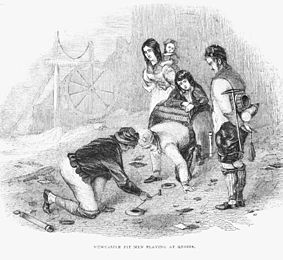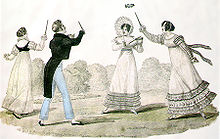- Quoits
-
For other uses, see Quoit (disambiguation).
Quoits 
Newcastle pit men playing quoitsQuoits (koits, kwoits) is a traditional game which involves the throwing of metal, rope or rubber rings over a set distance, usually to land over or near a spike (sometimes called a hob, mott or pin). The sport of quoits encompasses several distinct variations.
Contents
The history of quoits
The history of quoits is disputed. One theory often expressed is that the sport evolved as a formalised version of horseshoes,[1] which is a sport that involves pitching a horseshoe at a spike in the ground. A more likely explanation, however, is that horseshoes evolved from the sport of quoits, which in turn has its origins in ancient Greece.[2] On its website, the United States Quoiting Association explains that poorer citizens in ancient Greece, who could not afford to buy a real discus, made their own by bending horseshoes - which in those days weighed as much as four pounds each. The practice was adopted by the Roman army and spread across mainland Europe to Britain. The aim of the sport remained as a competition to see who could throw the object the furthest, until
at some later, undocumented point in history, perhaps around a few centuries A.D., the idea of using a wooden stake or metal pin driven into the ground, to use specifically as a target to throw at, totally redefined the pastime from a game of distance to a game of accuracy.[3]
Whilst the first quoits were apparently made from horseshoes, in the context of the game's evolution, the significant point is that they were initially closed to form a ring and only used in their open form after the practice of pitching at a spike had been established.
In England, quoits became so popular that is was prohibited by Edward III and Richard II to encourage archery.[4][unreliable source?] Despite this setback, by the 15th century there is evidence to show that it had become a well organised sport, not least because of the numerous attempts to eradicate it from the pubs and taverns of England due to its apparently seedy character.[citation needed]
It is not until the 19th century, however, that the game is documented in any detailed way. The official rules first appeared in the April 1881 edition of The Field, having been defined by a body formed from pubs in Northern England.[5]
The popularity of the game during the 19th and early 20th century[citation needed] also gave rise to several variants, usually with the aim of allowing the game (or a version of it) to be played indoors, or with the aim of making it accessible to women and children. Games such as ringtoss or hoopla became popular as parlour games, whilst versions such as indoor quoits allowed pubs and taverns to maintain their quoits teams through the winter months. Deck quoits began life sometime in the early 1930s as a pastime to occupy passengers on long cruises.
Variations
Traditional quoits
A game played with metal discs, traditionally made of steel, and thrown across a set distance at a metal spike (called a pin, hob or mott). The spike is centrally, and vertically, positioned in a square of moist clay measuring three feet across.
United Kingdom
The northern game
This version uses the 15 rules published in The Field in 1881 and has remained largely unchanged since that time. Played under the auspices of The National Quoits Association, formed in 1986.
In this game, the pins are 11 yards apart, with their tops protruding three to four inches above the clay. Quoits measure about 5½ inches in diameter and weigh around 5½ pounds.[6]
This version of the game is played by two leagues in and around the Esk Valley on Monday and Thursday evenings from early May to mid August. The following villages have teams that play the northern game: Ainthorpe, Beck Hole, Danby, Egton Bridge, Fryup, Glaisdale, Grosmont, Hawsker, Lealholm, Moorsholm and Fylingthorpe.[7]
The long game
Sometimes called the old game, this version is played in Wales and Scotland; Scotland had around a dozen clubs, now reduced to one which is based in Stonehaven, under the control of the Scottish Quoiting Association, whilst Wales has only a few clubs, based around Dyfed and Powys.
In this game, the top of the spike is flush with the clay, so encircling the pin is not a significant part of the game. The long game has similarities to the game of bowls, in that a player scores a point for each quoit nearer to the pin than his opponent. The hobs are 18 yards apart, while the quoits are typically around nine inches in diameter and weigh up to 11 pounds, almost double that of the northern game.[5]
East Anglian quoits
An English version of the long game, played using quoits of reduced size and weight. As with the long game, the hobs are 18 yards apart, but their tops are raised above the level of the clay. Quoits that land cleanly over the hob score two points, regardless of the opponent's efforts, and are removed immediately, prior to the next throw. Quoits which land on their backs, or inclined in a backwards direction, are also removed immediately
United States
Other countries
Indoor or table quoits
 A game of indoor quoits, being played in the Forest of Dean
A game of indoor quoits, being played in the Forest of Dean
Exclusively a pub game, this variant is predominantly played in mid and south Wales and in England along its border with Wales.
Matches are played by two teams (usually the host pub versus another pub) and typically consist of four games of singles, followed by three games of doubles. Players take it in turns to pitch four rubber rings across a distance of around 8½ feet onto a raised quoits board. The board consists of a central pin or spike and two recessed sections: an inner circular section called the dish and a circular outer section.
Five points are awarded for a quoit landing cleanly over the pin, two points for a quoit landing cleanly in the dish, and one point for a quoit landing cleanly on the outer circular section of the board. The scoreboard consists of numbers running from 1 to 10, 11 or 12, and the object of the game is to score each of these numbers separately using four or fewer quoits, the first side to achieve this being the winner.
Deck quoits
Deck quoits is a variant which is popular on cruise ships. The quoits are invariably made of rope, so as to avoid damaging the ship's deck, but there are no universally agreed standards or rules - partly because of the game's informal nature and partly because the game has to adapt to the shape and area of each particular ship it is played upon.
Players take it in turn to throw three or four hoops at a target which usually, though not always, consists of concentric circles marked on the deck. The centre point is called the jack. Occasionally this may take the form of a raised wooden peg, but more usually it is marked on the surface in the same way that the concentric circles are.
Slate-board quoits
This is a popular outdoor variation played principally in and around Pennsylvania, USA. This game uses two one-pound rubber quoits per player, which are pitched at a short metal pin mounted on a heavy 24x24x1 inch slab of slate.
Players take turns throwing a quoit at the pin. The quoit nearest the pin gets one point. If one player has two quoits nearer the pin than either of his opponent's quoits, he gets two points. A quoit that encircles the pin (called a ringer) gets three points. If all four quoits are ringers, the player who threw the last ringer wins the game; otherwise, the first player to make 21 points wins the game.
Garden quoits or hoopla
This version of the game exists largely as a form of recreation, or as a game of skill found typically at fairgrounds and village fetes.
There are no leagues or universally accepted standards of play and players normally agree upon the rules before play commences.
Garden quoit and hoopla sets can be purchased in shops and usually involve players taking it in turns to throw rope or wooden hoops over one or more spikes.
The fairground version typically involves a person paying the stallholder for the opportunity to throw one or more wooden hoops over a prize, which if done successfully, they can keep. Generally speaking, the odds of winning are normally heavily weighted in favour of the stallholder.
Current leagues
Traditional quoits
United Kingdom
- Allen Valley Quoits League, Northumberland.[8]
- Danby Invitation Quoits League, North Yorkshire.[7]
- North Yorkshire Moors League, North Yorkshire.[7]
- Montgomeryshire County Quoits League, Montgomeryshire.[9]
United States
- United States Quoiting Association (USQA) see USQA.org
- Mercer County Church Steel Quoit League, New Jersey.[10]
Other countries
Indoor quoits
United Kingdom
- Forest of Dean Quoits League, Gloucestershire.[11]
- The Builth Wells and District League, Powys.[12]
- Kington League, Herefordshire.[11]
- Aymestry League, Herefordshire.[11]
- Presteigne League, Powys.[11]
- The Whitby Indoor League, North Yorkshire.[7]
Slate-board quoits
United States
- Bushkill Valley Quoit League, Pennsylvania.[13]
- Easton City Quoit League, New Jersey.[14]
- Slate Belt Quoit League, Pennsylvania.[15]
See also
References
- ^ http://www.tradgames.org.uk/games/Quoits.htm
- ^ http://quoits.info/history/history.html
- ^ United States Quoiting Association[unreliable source?]
- ^ Etymology Dictionary
- ^ a b Quoits Online
- ^ Allen Valley League Rules
- ^ a b c d http://www.tradgames.org.uk/locations/Quoits.htm
- ^ http://www.allenvalleyquoits.co.uk/
- ^ http://www.bbc.co.uk/wales/mid/sites/sport/pages/quoits.shtml
- ^ http://mccsql.tripod.com/
- ^ a b c d http://www.tradgames.org.uk/locations/Quoits-Indoor.htm
- ^ The Builth Wells and District League
- ^ http://www.quoitsdirect.com/OrganizedLeagues/BushkillValleyQuoitLeague.htm
- ^ http://www.quoitsdirect.com/OrganizedLeagues/EastonCityQuoitLeague.htm
- ^ http://www.quoitsdirect.com/OrganizedLeagues/SlateBeltQuoitLeague.htm
External links
- The Pennsylvania Version of Traditional Rubber Quoits: Quoits Direct
- The Online Guide to Traditional Games: Quoits
- The American Version of Traditional Iron Quoits: quoits.info
- The United States Quoiting Association: usqa.org
- Historic Richmond Foundation [1]
- Game Rules for Rubber Quoits on Slate Quoitboards: Quoit Rules
Categories:- Lawn games
- Pub games
Wikimedia Foundation. 2010.


